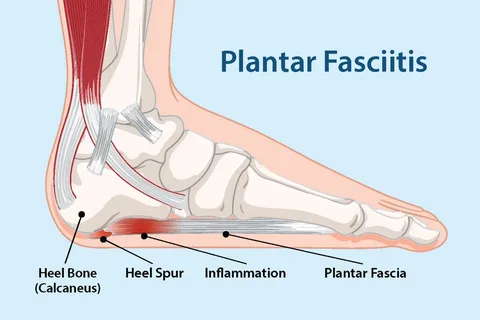Heel discomfort might start as a mild annoyance but can quietly evolve into a lasting condition if left untreated. Many people assume the soreness will fade with rest, yet prolonged strain on the plantar fascia often leads to chronic tendon damage and deep inflammation. Early treatment by a plantar fasciitis doctor prevents this small irritation from becoming a long-term mobility problem.
Repeated Heel Stress Turns Minor Pain into Chronic Strain
Daily standing, running, or walking on a stressed heel repeatedly tears at the fascia tissue. Without recovery time, these small tears become permanent, creating thickened scar tissue and stiffness that make each step more painful. A plantar fasciitis specialist identifies these micro-tears early and recommends exercises or therapies that prevent them from escalating into chronic strain.
Ignoring the recurring tension causes the fascia to lose elasticity. Over time, the ligament connecting the heel to the toes becomes less flexible and more prone to tearing again. This cycle of strain and limited recovery leads to a persistent ache that doesn’t respond to over-the-counter pain relief, signaling the need for professional care.
Ignored Inflammation Disrupts Normal Tendon Repair Cycles
Inflammation is the body’s response to tissue injury, but when the process continues unchecked, it stops being helpful. Persistent swelling in the heel interrupts the natural healing rhythm that allows damaged fibers to regenerate. A plantar fasciitis doctor uses targeted treatments to reduce inflammation before it interferes with the repair cycle.
As inflammation lingers, blood flow becomes irregular, delaying tissue rebuilding and weakening nearby tendons. Chronic swelling also causes fluid accumulation that stiffens the surrounding muscles and fascia. This environment prevents proper recovery and contributes to recurring heel pain that grows harder to treat with time.
Unchecked Pressure Causes Tissue Fibers to Degenerate
Constant load-bearing on the heel puts extraordinary pressure on the fascia’s collagen fibers. Without rest or medical support, the fibers begin to fray, losing the smooth alignment that keeps the fascia strong. Over time, degeneration sets in, leading to thickened, uneven tissue that strains with every movement.
A plantar fasciitis specialist can identify early signs of fiber breakdown using diagnostic imaging or physical evaluation. Through physical therapy, orthotic support, and guided stretching, these professionals relieve stress before irreversible damage occurs. Ignoring the condition only allows degeneration to spread, making future recovery much slower.
Ongoing Discomfort Alters Natural Foot Alignment
Pain naturally changes how a person walks or stands. To avoid discomfort, many shift their weight to one side or shorten their stride, unknowingly altering their gait. These compensations put extra stress on the ankles, knees, and hips, spreading the problem beyond the heel.
A plantar fasciitis doctor often observes that prolonged discomfort changes posture and joint alignment, leading to muscle imbalances. Corrective care, such as custom inserts or guided rehabilitation, helps retrain proper movement. Left untreated, these misalignments become permanent, creating new pain points throughout the lower body.
Continuous Overload Triggers Deeper Fascia Irritation
The plantar fascia isn’t an isolated structure; it interacts with muscles, ligaments, and nerves throughout the foot. Continuous overload irritates these connected tissues, making the pain radiate beyond the heel. What began as a localized problem soon affects the arch and forefoot.
A plantar fasciitis specialist focuses on reducing strain throughout the entire chain of foot motion. By balancing pressure distribution and improving flexibility, they restore harmony across the fascia network. Ignoring this deeper irritation allows pain to spread and intensify, often leading to nerve sensitivity and chronic discomfort.
Long-term Neglect Heightens Risk of Heel Spur Formation
Ignoring plantar fasciitis often results in heel spurs—bony growths that develop where the fascia attaches to the heel bone. These spurs form as the body tries to reinforce weakened tissue, but they create additional friction that worsens inflammation. A plantar fasciitis doctor can detect and treat these formations before they become severely painful.
Heel spurs rarely appear overnight. They are the result of repeated tension over many months, making prevention the best strategy. Addressing fascia strain early not only reduces the chance of spur development but also restores natural walking comfort before permanent changes occur.
Persistent Swelling Limits Nutrient Flow to Damaged Areas
Tendon recovery depends on healthy blood circulation. Chronic swelling compresses small blood vessels, reducing the oxygen and nutrients that damaged fascia needs to repair. As circulation declines, healing slows, and tissue health deteriorates.
A plantar fasciitis specialist often prescribes treatments that enhance microcirculation, such as deep tissue therapy or anti-inflammatory modalities. By improving nutrient delivery, these therapies help restore fascia strength. Ignoring persistent swelling leads to long-term tissue weakness and slower recovery after even minor activity.
Compensatory Gait Habits Spread Tension to the Ankles and Knees
As heel pain intensifies, individuals unconsciously adjust how they walk to protect the sore area. These altered patterns create new strain on the ankles and knees, causing discomfort in joints that were previously healthy. A plantar fasciitis doctor identifies these gait changes before they evolve into secondary injuries.
Over months of walking this way, the imbalance places uneven pressure across the lower limbs. This compensation can lead to knee inflammation, ankle instability, or even hip misalignment. Addressing plantar fasciitis early prevents this ripple effect, maintaining balance and joint health throughout the body.

